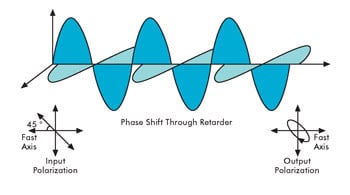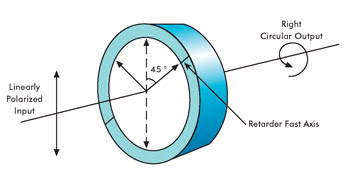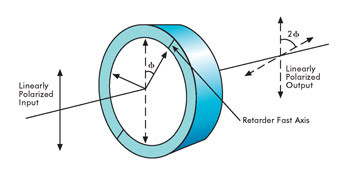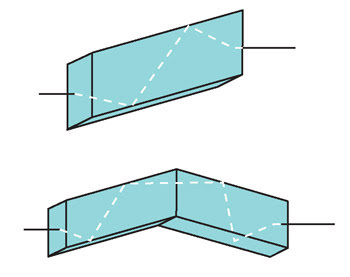Matching the material to the intended use leads to success.
William Barbarow, Meadowlark Optics Inc.
The applications for wave plates are many and varied. They can find use in areas such as power attenuation of a laser and optical isolation. In biomedical applications, wave plates are used to determine the polarization of body fluids in microscopes and to correct for unwanted phase shifts. They are also used in astronomy, in the semiconductor industry and in aerospace. In short, almost every application that requires polarized light uses a wave plate to control polarization. The materials used for them are determined by the application. These options include a wide array of birefringent crystalline materials, total internal reflection retarders, polymer retarders and liquid crystals.

A retarder introduces a phase shift between the two orthogonal directions. This causes the polarization to change.
How a wave plate works
A wave plate produces a phase shift between the two orthogonal polarizations of a light wave. This is done via birefringence, or when the index of refraction along the slow axis differs from that along the fast axis. Common wave-plate retardances include quarter- and half-wave plates. The quarter-wave plate turns linearly polarized light into circularly polarized light with the input light at a 45° angle between the fast and slow axes. The half-wave plate is a polarization rotator as it flips the polarization direction around the fast axis of the retarder. These are manufactured from various materials, depending on the application, with costs ranging from tens to thousands of dollars.

A quarter-wave plate converts linearly polarized input light into circularly polarized light when the input light is 45° to the fast axis.
Key specifications include the wavelength, retardance accuracy, dimensions and the order of the retarder (which affects other specifications). A true zero-order retarder has the retardance specified with no additional waves. True zero-order wave plates have increased bandwidth and acceptance angle and good thermal performance. Because of the thinness of the retarder material, they are laminated between glass windows to increase robustness. A multiple-order retarder is more sensitive to changes in the incident angle, wavelength and temperature. A compound zero-order retarder is one that is manufactured from two multiple-order wave plates that are positioned together with their axes crossed to get an overall retardance of less than one wave. Compound zero-order retarders have a lower sensitivity to changes in temperature and wavelength than multiple-order retarders but have smaller acceptance angles.

A half-wave plate is used as a polarization rotator, flipping the polarization around the fast axis.
Wave plate materials
Quartz is the most commonly used retarder material. It is easy to find and manufacture, is inexpensive and operates from 180 to 2300 nm. Quartz retarders are fabricated with the optic axis in the surface plane and then polished to the desired thickness and retardance. Quartz has good surface quality and a high laser damage threshold – more than 1 MW. To maximize transmission, most quartz retarders are antireflection-coated. Three different constructions of quartz retarders impact their bandwidth, their off-axis and their thermal performance. Multiple-order retarders have considerable temperature, off-axis and wavelength variations. True zero-order retarders improve on all of these specifications, while compound zero-order quartz wave plates have a larger bandwidth and better thermal stability but a worse field of view. For applications over a large wavelength range, a bicrystalline achromat can be manufactured out of quartz and another crystal, such as magnesium fluoride, to get a 300-nm bandwidth, but it has a limited field of view. This can be corrected by combining quartz with a negative birefringent material, such as sapphire.
Mica, which is used over the 400- to 2000-nm range and is transparent to 6 µm, can be cleaved to the correct thickness for the desired retardance. Mica retarders are used for low-power imaging applications; however, spatial uniformity problems can sometimes result. The long-term outlook on the supply of optical-grade mica, a naturally occurring birefringent crystal, is uncertain. This makes large parts with large clear apertures expensive and hard to obtain.
Magnesium fluoride is used with quartz to manufacture bicrystalline achromatic retarders that operate from the ultraviolet to the infrared. It is also used as the sole wave plate material for ultraviolet retarders down to 121 nm and for mid-infrared retarders from 3 to 7 µm, because it has higher transmission than quartz.
Sapphire has a negative birefringence, as the index of refraction of the extraordinary axis is less than that of the ordinary axis. This makes sapphire useful for bicrystalline achromatic retarders with a large field of view. Its main advantage, when used by itself, is that it has a higher laser damage threshold with low absorption. However, sapphire is more expensive than quartz and magnesium fluoride, and polishing it is usually a long process.

A quarter-wave Fresnel rhomb (above) and a half-wave version (below).
Fresnel rhombs are achromatic retarders that use total internal reflection to induce retardation and prisms that are parallelepiped. Each time light hits a prism wall and is reflected, a one-eighth phase shift is produced. Therefore, two reflections in a single rhomb cause a quarter wave of retardance, and four reflections in a double rhomb cause a half wave of retardance. Common materials include BK-7 glass, FK5, fused silica and calcium fluoride. Fresnel rhombs are used from the ultraviolet to 2000 nm, with a retardance accuracy of 1 or 2 percent, and are found at prices comparable to those of bicrystalline achromatic retarders.
Polymer pros and cons
Birefringent polymer is “tuned” to the retardance at the operating wavelength, making custom retardances easy to manufacture. The polymer is true zero order, with an excellent field of view and thermal performance in the visible and near-infrared. However, polymer is susceptible to ultraviolet damage and has a lower laser damage threshold than crystalline retarders. By stacking polymer, one can manufacture achromatic retarders that work over a couple hundred nanometers with retardance accuracy of less than 1 percent. Other polymer stacks can be used for retarders made with large acceptance angles – up to 30° – and for dual-wavelength retarders that allow the user to have two retardances at different wavelengths hundreds of nanometers apart.
Sometimes active retarders are required. Liquid crystals require a drive voltage to change the retardance for the visible and near-infrared. Nematic liquid crystals have response times in the tens of milliseconds and are manufactured in sizes as large as several inches in diameter and as small as about 10 mm. Recently, developments have led to polymer-stabilized nematic liquid crystals with a response time of around 100 µs.
Wave plates manipulate the polarization of light and control it for numerous applications that are in use today. Because retarders are made from many different materials, it is easy to become confused as to which wave plate will work best for your application. The best material depends on the various wavelengths, applications and other optical specifications. By identifying the specifications most crucial for your application, you can determine the wave plate that is optimal for controlling the polarization.
Meet the author
William Barbarow is a sales engineer at Meadowlark Optics in Frederick, Colo.; e-mail: [email protected].